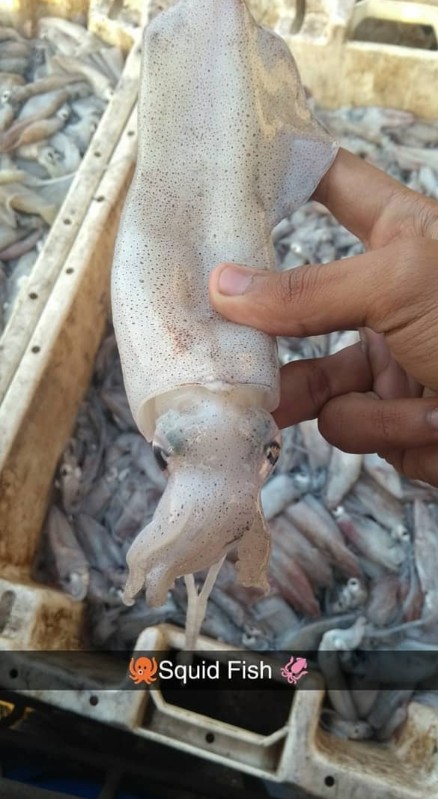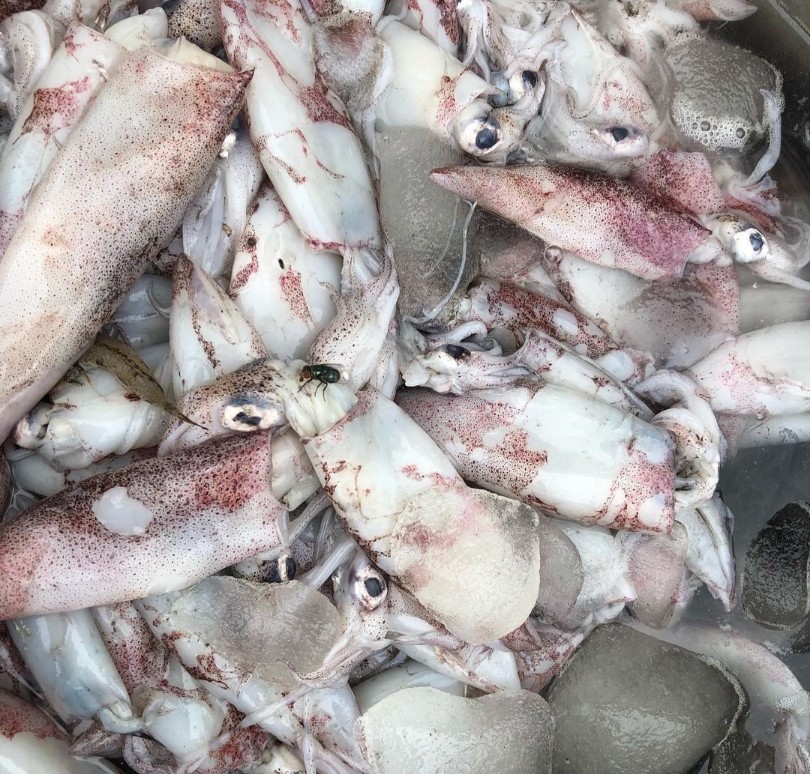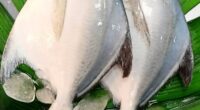Introduction to Kadamba Fish (Squid)
Kadamba Fish, also known as squid in English, is a type of cephalopod mollusk that belongs to the order Teuthida. It is a popular seafood delicacy enjoyed for its mild and slightly sweet flavor, as well as its unique, gelatinous texture. Squid is often used in various culinary applications and is known for its ability to absorb flavors, making it a versatile ingredient in a wide range of dishes.

This seafood is typically found in coastal regions and is a staple in the traditional cuisines of places like Goa and Kerala in India. It has a rich history in these regions, with recipes and cooking methods passed down through generations. Squid Fish, or squid, is not only appreciated for its taste but also for its nutritional value, being a good source of protein, vitamin B12, selenium, and other essential nutrients.
Due to its adaptability in the kitchen and its ability to pair well with various spices and ingredients, Squid Fish has gained popularity among chefs and home cooks worldwide. It can be grilled, sautéed, stir-fried, deep-fried, or even used in salads and soups, offering a delightful culinary experience to those who savor it.
Characteristics of Kadamba Fish (Squid)

Kadamba Fish, or squid, is recognized for its distinctive characteristics. It has a cylindrical body with a soft, almost gelatinous texture. Its mild and slightly sweet flavor makes it a versatile ingredient in various dishes.
The texture of squid Fish, is another standout feature. When cooked properly, it retains its firmness while offering a delightful contrast of textures.
Nutritional Value
The nutritional goodness of Kadamba Fish, also known as squid in English, makes it a popular and healthy seafood choice. This cephalopod mollusk offers a range of essential nutrients and health benefits:
- Protein Powerhouse
Kadamba Fish (squid) is a protein powerhouse. It provides a generous amount of high-quality protein, with a 100-gram serving containing approximately 15 grams of protein. Protein is essential for various bodily functions, including muscle repair and growth, immune system support, and the production of enzymes and hormones. Incorporating squid Fish into your diet can help meet your protein needs, making it an excellent choice for athletes, fitness enthusiasts, and anyone looking to maintain or build muscle.
- Vitamin B12 Abundance
One standout feature of Kadamba Fish is its impressive vitamin B12 content. A 100-gram serving of squid contains approximately 2.4 micrograms of vitamin B12, which is a remarkable 100% of the recommended daily intake. Vitamin B12 is vital for several critical functions in the body. It plays a crucial role in maintaining healthy nerve cells, supporting DNA production, and participating in the formation of red blood cells. A sufficient intake of vitamin B12 is essential for overall well-being, and including squid Fish in your diet can help meet this nutritional requirement.
- Selenium’s Protective Power
Squid is also a rich source of selenium, an essential mineral with potent antioxidant properties. A 100-gram serving of Kadamba Fish provides approximately 44 micrograms of selenium, accounting for 80% of the recommended daily intake. Selenium serves as a powerful defender against oxidative stress, helping protect cells from damage caused by free radicals. Moreover, selenium plays a crucial role in maintaining thyroid health and supporting a robust immune system. Incorporating selenium-rich foods like squid Fish into your diet can contribute to overall health and well-being.
- Phosphorus for Strong Bones and Teeth
Phosphorus, another valuable nutrient found in Kadamba Fish, is essential for the body’s structural integrity. A 100-gram serving of squid contains around 192 milligrams of phosphorus, which is roughly 19% of the recommended daily intake. Phosphorus is primarily known for its role in bone and teeth health. It partners with calcium to form the mineral structure of bones and teeth, promoting their strength and density. Beyond its skeletal benefits, phosphorus also participates in various cellular processes, making it a vital nutrient for overall health.
- Low in Fat and Calories
One of the health-conscious aspects of Kadamba Fish (squid) is its naturally low-fat content. This makes it an attractive option for those aiming to manage their dietary fat intake while still enjoying flavorful seafood. Additionally, a 100-gram serving of squid contains approximately 85 calories, making it a relatively low-calorie choice. For individuals mindful of calorie consumption, squid Fish offers a nutritious and satisfying option that can be integrated into balanced diets.
In a 100-gram serving of squid, you can expect to find:
- Protein: 15 grams
- Calories: 85 kcal
- Vitamin B12: 2.4 micrograms (100% of the recommended daily intake)
- Selenium: 44 micrograms (80% of the recommended daily intake)
- Phosphorus: 192 milligrams (19% of the recommended daily intake)
In conclusion, Kadamba Fish (squid) is not only a culinary delight but also a nutritional powerhouse. Its protein content supports muscle health, vitamin B12 bolsters overall well-being, selenium provides antioxidant protection, and phosphorus contributes to strong bones and teeth. Moreover, its low-fat and calorie content make it a smart choice for those seeking a nutritious and delicious addition to their meals. Including squid Fish in your diet allows you to savor its flavors while reaping the numerous nutritional benefits it has to offer.
The Healthiest Way to Eat Kadamba Fish
When it comes to savoring the health benefits of Kadamba Fish, also known as squid in English, the key lies in choosing the right cooking methods and ingredients to maximize its nutritional value while keeping it delicious. Here’s the healthiest way to eat Kadamba Fish:
- Grilling or Broiling: Grilling or broiling Kadamba Fish is one of the healthiest ways to prepare it. These methods require minimal added fats, allowing you to enjoy the natural flavors of the seafood. Brush the squid with a small amount of olive oil and season it with herbs, spices, and citrus for added flavor. Grilling or broiling also imparts a smoky, charred taste that complements the squid’s mild flavor.
- Sautéing with Minimal Oil: Sautéing Kadamba Fish in a non-stick pan with minimal oil is another healthy cooking option. Use heart-healthy oils like olive oil or avocado oil sparingly. Add garlic, onions, and a variety of colorful vegetables to create a nutrient-rich and flavorful dish. The squid’s tender texture absorbs the flavors of the aromatic ingredients, making it a delightful and nutritious meal.
- Steaming: Steaming Kadamba Fish retains its natural moisture and nutrients. This gentle cooking method ensures that the squid remains tender and doesn’t become overcooked or tough. Steam Kadamba Fish with a medley of vegetables and herbs for a light and nutritious dish. Drizzle with a lemon or lime dressing to enhance its taste.
- Stir-Frying with Veggies: Stir-frying Kadamba Fish with an assortment of colorful vegetables is not only visually appealing but also a healthy choice. Use a minimal amount of oil and stir-fry over high heat for a short time to preserve the squid’s texture and nutrients. Add a soy-based sauce or a light dressing for extra flavor.
- Raw in Seafood Salad: If you enjoy raw seafood, consider including thinly sliced or chopped Kadamba Fish in a seafood salad. Combine it with other fresh seafood like shrimp and scallops, along with an array of crisp vegetables and herbs. Season with a citrusy vinaigrette for a refreshing and nutritious salad option.
- Avoid Heavy Breading and Frying: While fried calamari is a popular dish, it’s best to limit consumption of deep-fried Kadamba Fish as it can add excess calories and unhealthy fats. If you choose to indulge occasionally, opt for a lighter breading and shallow frying in heart-healthy oils.
The Perfect Kadamba Fish (Squid) Recipe kadamba fish curry
To truly savor the flavors of Kadamba Fish (squid), try this mouthwatering recipe: “Squid Ink Pasta with Garlic and Tomatoes.” This dish combines the squid’s unique taste with aromatic spices and tomatoes for a delightful culinary experience.
Ingredients:
- 250g squid ink pasta
- 250g fresh squid, cleaned and sliced into rings
- 3 tablespoons olive oil
- 4 cloves garlic, minced
- 1 cup cherry tomatoes, halved
- 1/4 cup fresh basil leaves, torn
- Salt and black pepper to taste
- Grated Parmesan cheese for garnish
Instructions:
- Cook the squid ink pasta according to package instructions until al dente. Drain and set aside.
- Heat olive oil in a pan over medium heat. Add minced garlic and sauté until fragrant.
- Add the squid rings and cook for 2-3 minutes until they turn opaque.
- Stir in the cherry tomatoes and cook for an additional 2 minutes until they start to soften.
- Toss in the cooked squid ink pasta and fresh basil. Season with salt and black pepper. Cook for another 2 minutes to combine the flavors.
- Serve hot, garnished with grated Parmesan cheese.
This Squid Ink Pasta with Garlic and Tomatoes is a testament to the squid’s ability to create a dish that’s both visually striking and bursting with flavor.
Remember to season your Kadamba Fish with herbs, spices, and citrus juices rather than excessive salt to enhance its flavors. Additionally, pairing it with a variety of vegetables and whole grains can create a well-balanced and nutritious meal. By preparing and enjoying squid Fish using these healthier methods, you can relish its taste while reaping its numerous health advantages.
Who Should Not Eat Kadamba Fish
While Kadamba Fish, also known as squid in English, offers a plethora of health benefits and is a delectable addition to many diets, there are specific individuals who should exercise caution or consider limiting their consumption of Kadamba Fish due to various factors:
- Allergic Reactions:Some individuals may have allergies to seafood, including Kadamba Fish. Allergic reactions to seafood can range from mild symptoms like itching and hives to severe reactions that involve difficulty breathing and anaphylaxis. Anyone with a known seafood allergy should strictly avoid Kadamba Fish and other seafood to prevent potentially life-threatening reactions.
- Shellfish Allergies:It’s important to note that Kadamba Fish (squid) falls into the category of shellfish. Individuals with shellfish allergies, which can encompass both crustaceans like shrimp and mollusks like Kadamba Fish, need to be cautious. Cross-contamination is a concern, so even if someone is only allergic to one type of shellfish, they may react to other shellfish varieties. Strict avoidance is generally recommended for those with shellfish allergies.
- Iodine Sensitivity:Kadamba Fish contains iodine, a mineral that is naturally present in seafood. While iodine is essential for thyroid function and overall health, individuals with iodine sensitivity or those who are on a medically prescribed low-iodine diet should monitor their seafood intake, including Kadamba Fish, as part of their dietary restrictions. It’s advisable for them to consult with a healthcare professional or dietitian for personalized guidance.
- Pregnant and Nursing Women:Pregnant and nursing women are often advised to be cautious about their seafood consumption due to concerns about mercury levels. While Kadamba Fish generally contains lower levels of mercury compared to some other seafood, it’s essential for expectant and breastfeeding mothers to choose seafood carefully. They should follow recommendations provided by healthcare providers regarding safe seafood options during pregnancy and lactation to minimize potential risks.
- Individual Dietary Preferences and Restrictions:Individuals who follow specific dietary preferences or restrictions, such as vegetarian or vegan diets, may choose to avoid seafood altogether, including Kadamba Fish (squid), due to their personal beliefs or dietary choices. In such cases, it’s important to select alternative protein sources that align with their dietary preferences.
In summary, while Kadamba Fish (squid) is a flavorful and nutritious seafood option for many people, individuals with seafood allergies, shellfish allergies, iodine sensitivity, and pregnant or nursing women need to be cautious or avoid it, depending on their specific circumstances and dietary recommendations. Always consult with a healthcare professional or allergist if you have concerns about consuming Kadamba Fish or any other food due to allergies or medical conditions.
health benefits of Kadamba Fish

Kadamba Fish, also known as squid in English, offers a host of health benefits that make it a valuable addition to your diet. Here’s a closer look at how consuming Kadamba Fish can positively impact your well-being:
- Rich in Protein: Kadamba Fish is a protein-packed seafood option. With approximately 15 grams of protein per 100-gram serving, it’s an excellent choice for individuals looking to meet their protein needs. Protein is crucial for muscle repair and growth, making Kadamba Fish an ideal choice for athletes, fitness enthusiasts, and those seeking to maintain or build muscle mass.
- Vitamin B12 Boost: One of the standout health benefits of Kadamba Fish is its abundant vitamin B12 content. A 100-gram serving of squid contains around 2.4 micrograms of vitamin B12, providing 100% of the recommended daily intake. Vitamin B12 is essential for maintaining healthy nerve cells, producing DNA, and supporting red blood cell formation. Ensuring an adequate intake of vitamin B12 is vital for overall well-being, and Kadamba Fish can be a delicious source of this essential nutrient.
- Selenium’s Protective Power: Kadamba Fish is also a rich source of selenium, with a 100-gram serving offering approximately 44 micrograms, accounting for 80% of the recommended daily intake. Selenium acts as a potent antioxidant, guarding against oxidative stress and protecting cells from damage caused by free radicals. Additionally, selenium plays a role in thyroid health and supports a robust immune system. Incorporating selenium-rich foods like Kadamba Fish into your diet can contribute to overall health and wellness.
- Low in Fat and Calories: For those mindful of their dietary fat and calorie intake, Kadamba Fish (squid) presents a smart choice. It naturally boasts a low-fat content, making it a heart-healthy option. Moreover, a 100-gram serving contains approximately 85 calories, making it a relatively low-calorie choice. This characteristic makes Kadamba Fish a nutritious and satisfying addition to balanced diets, especially for those aiming to manage their calorie consumption.
- Lean Protein Source: The protein found in Kadamba Fish is lean, meaning it offers protein without excess saturated fat. This attribute makes it an appealing option for individuals seeking to increase their protein intake while keeping their fat intake in check. Lean protein sources like Kadamba Fish support overall health and may assist in weight management and heart health.
In conclusion, Kadamba Fish (squid) isn’t just a culinary delight; it also delivers a range of health benefits. Its high protein content aids in muscle health, while its substantial vitamin B12 levels promote overall well-being. The presence of selenium provides antioxidant protection and supports immune function, and its low-fat and calorie content make it an attractive choice for those with dietary considerations. By incorporating Kadamba Fish into your diet, you can savor its flavors while reaping the numerous health advantages it offers.
Side Effect of Kadamba Fish
While Kadamba Fish, also known as squid in English, is generally considered a safe and nutritious seafood option, there are certain considerations and potential side effects associated with its consumption:
- Allergic Reactions: Individuals with seafood allergies may experience allergic reactions when consuming Kadamba Fish. Symptoms can vary from mild itching and hives to severe reactions like difficulty breathing and anaphylaxis. It’s crucial for those with known seafood allergies to strictly avoid Kadamba Fish and other seafood to prevent allergic episodes.
- Cross-Contamination: Cross-contamination is a concern, especially for individuals with shellfish allergies. Kadamba Fish (squid) belongs to the category of shellfish, and exposure to other shellfish varieties can trigger allergic reactions in sensitive individuals. Careful handling and preparation of Kadamba Fish in environments where cross-contamination may occur are essential.
- Iodine Sensitivity: Kadamba Fish naturally contains iodine, a mineral important for thyroid function. Individuals with iodine sensitivity or those on a medically prescribed low-iodine diet may need to monitor their Kadamba Fish consumption. Consultation with a healthcare professional or dietitian is advisable to ensure dietary restrictions are met.
- Mercury Concerns: While Kadamba Fish generally contains lower levels of mercury compared to some other seafood, it’s essential for pregnant and nursing women to consider potential mercury exposure. High levels of mercury during pregnancy can harm fetal development. Pregnant and breastfeeding women should follow healthcare provider recommendations regarding safe seafood choices to minimize mercury exposure.
- Digestive Sensitivity:Some individuals may experience digestive discomfort, such as indigestion or gastrointestinal upset, after consuming Kadamba Fish if it is not properly cooked or if they have a sensitive digestive system. Ensuring thorough cooking and moderation in consumption can help mitigate these effects.
- Individual Dietary Preferences and Restrictions: Individuals following specific dietary preferences or restrictions, such as vegetarian or vegan diets, may choose to avoid seafood, including Kadamba Fish, due to personal beliefs or dietary choices. Respect for these preferences is important, and alternative protein sources should be considered.
It’s essential to note that while potential side effects exist, they are relatively rare, and Kadamba Fish is a safe and nutritious choice for most individuals. However, those with known allergies, sensitivities, or dietary restrictions should exercise caution and consult with healthcare professionals or dietitians as needed to ensure safe and appropriate consumption of squid Fish.
FAQs
Where can I buy fresh squid (Kadamba Fish)?
You can purchase fresh squid, known as Kadamba Fish, at local fish markets, seafood stores, and some supermarkets. In coastal regions, you may even find it available directly from fishermen.
What is the best way to cook squid?
Squid can be cooked in various ways, including grilling, sautéing, frying, and even serving it raw in sushi. The best method depends on your preference and the recipe you’re following. For example, grilling squid imparts a smoky flavor, while sautéing it with garlic and herbs brings out its delicate taste.
Is squid a healthy seafood choice?
Yes, squid is a healthy seafood choice. It is low in calories and fat while being a good source of protein, vitamin B12, and selenium. Additionally, it is rich in essential minerals like phosphorus, making it a nutritious addition to your diet.
How can I support sustainable squid fishing?
To support sustainable squid fishing, look for seafood products with sustainability certifications, such as the Marine Stewardship Council (MSC) label. Additionally, inquire about the source of the squid when purchasing it and choose products that prioritize responsible fishing practices.
What are some popular international squid dishes?
Squid is featured in a variety of international dishes. Some popular examples include calamari (fried squid rings), Spanish squid ink paella, Japanese calamari sushi, and Mediterranean grilled squid. Exploring these dishes can provide you with a diverse culinary experience using squid.





